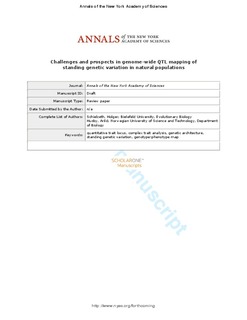| dc.contributor.author | Schielzeth, Holger | |
| dc.contributor.author | Husby, Arild | |
| dc.date.accessioned | 2014-08-29T07:13:16Z | |
| dc.date.accessioned | 2016-06-20T11:13:34Z | |
| dc.date.available | 2014-08-29T07:13:16Z | |
| dc.date.available | 2016-06-20T11:13:34Z | |
| dc.date.issued | 2014 | |
| dc.identifier.citation | Annals of the New York Academy of Sciences 2014, 1320:35-57 | nb_NO |
| dc.identifier.issn | 0077-8923 | |
| dc.identifier.uri | http://hdl.handle.net/11250/2393232 | |
| dc.description.abstract | A considerable challenge in evolutionary genetics is to understand the genetic mechanisms that facilitate or impede
evolutionary adaptation in natural populations. For this, we must understand the genetic loci contributing to trait
variation and the selective forces acting on them. The decreased costs and increased feasibility of obtaining genotypic
data on a large number of individuals have greatly facilitated gene mapping in natural populations, particularly
because organisms whose genetics have been historically difficult to study are now within reach. Here we review the
methods available to evolutionary ecologists interested in dissecting the genetic basis of traits in natural populations.
Our focus lies on standing genetic variation in outbred populations. We present an overview of the current state of
research in the field, covering studies on both plants and animals. We also draw attention to particular challenges
associated with the discovery of quantitative trait loci and discuss parallels to studies on crops, livestock, and humans.
Finally, we point to some likely future developments in genetic mapping studies. | nb_NO |
| dc.language.iso | eng | nb_NO |
| dc.publisher | Wiley | nb_NO |
| dc.title | Challenges and prospects in genome wide QTL mapping of standing genetic variation in natural populations. | nb_NO |
| dc.type | Journal article | nb_NO |
| dc.date.updated | 2014-08-29T07:13:17Z | |
| dc.description.version | submittedVersion | |
| dc.source.volume | 1320 | nb_NO |
| dc.source.journal | Annals of the New York Academy of Sciences | nb_NO |
| dc.source.issue | 1 | nb_NO |
| dc.identifier.doi | 10.1111/nyas.12397 | |
| dc.identifier.cristin | 1146113 | |
| dc.relation.project | Norges forskningsråd: 214553 | nb_NO |
| dc.description.localcode | © 2014 New York Academy of Sciences. This is the authors' manuscript to the article. | nb_NO |
